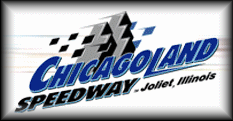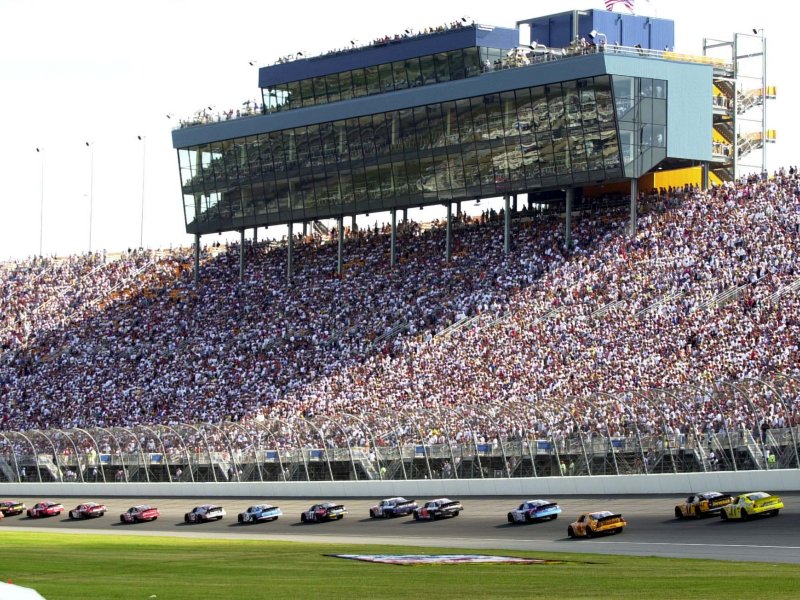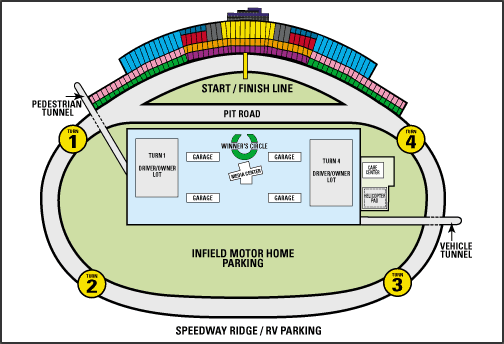


 TRACK SPECSAdjacent to its sister track, Route 66 Raceway, Chicagoland Speedway in Joliet, Illinois is a $130 million, 1.5-mile, D-shaped tri-oval speedway that annually hosts the NASCAR Winston Cup Series, NASCAR Busch Series, True Value International Race of Champions, ARCA RE/MAX Series, IRL Infiniti Pro Series and IRL IndyCar Series. Chicagoland Speedway sits on 930 acres of land, which is large enough to accommodate 42 United Centers (Home of the Chicago Bulls and Blackhawks). Chicagoland Speedway provides 700 acres of free parking for over 50,000 vehicles. GRANDSTANDS AND SUITES Number of Seats: 75,000 Number of Suites: 32 The height of the grandstands is 15 stories tall, which is the same height as the Navy Pier Ferris Wheel in downtown Chicago. The grandstands are 2,480 ft. long, which is slightly longer than two John Hancock buildings laid end-to-end. INFIELD Media Center: 3,500 Square-Ft. Care Center: 3,900 Square-Ft. RV Spots: 250 - Infield 78 - Outside the track, along the back stretch The infield is 1,200 Ft. x 2,850 Ft., which is equivalent to four Soldier Fields (Home of the Chicago Bears). GARAGES Size: 11,050 Square Ft. Number of Garages: 4 Number of Bays: 120 FRONT STRETCH Banking: 11 Degrees Length: 2,400 Ft. Width: 55 Ft. Apron Width: 27 Ft. PIT ROAD Number of Stalls: 43 (Stock Car) 34 (Open-Wheel) TURNS 1 & 2 Banking Turn 1: 18 Degrees Width Turn 1: 55 Ft. Apron Width: 27 Ft. Banking Turn 2: 18 Degrees Width Turn 2: 55 Ft. Apron Width: 27 Ft. BACK STRETCH Banking: 5 Degrees Length: 1,700 Ft. Width: 55 Ft. Apron Width: 24 Ft. TURNS 3 & 4 Banking Turn 3: 18 Degrees Width Turn 3: 55 Ft. Apron Width: 27 Ft. Banking Turn 4: 18 Degrees Width Turn 4: 55 Ft. Apron Width: 27 Ft. TRACK HISTORYCourtesy of www.chicagoland.comThe Historic Route 66 has always held a close place in the hearts of many a motorist and history buff. A true symbol of an era of nostalgia, Historic Route 66 soon entered into another phase of history in 1997 when nine Joliet area entrepreneurs had the visionary leadership to create Route 66 Raceway, a state-of-the-art �-mile Drag Strip and �-mile Dirt Oval Track facility, along the historic road. Several years later, the growing popularity of auto racing and the demand from loyal fans would bring to the site of Route 66 Raceway, the 1.5-mile tri-oval Chicagoland Speedway. With the addition of the 75,000-seat, $130 million Speedway, Joliet�s world-class motorsports complex would form what is now Illinois� largest sporting facility, occupying over 1,300-acres. Dating back to 1895, when the first ever gasoline-powered race was held up-and-down the Chicago lakefront, Illinois has played a significant role in establishing motorsports as one of the most exciting and popular spectator sports in the world. Now, Joliet�s Chicagoland Speedway/Route 66 Raceway has written a new chapter in Illinois� long and prestigious racing history. This magnificent speedway is the result of over five years of painstaking effort by Indianapolis Motor Speedway President Tony George, International Speedway Corporation Chief Executive Officer Bill France and nine local Joliet entrepreneurs: George Barr, Jim Bingham, Dale Coyne, Jerry Papesh, Ed Rensi, Steve Spiess, Dale Steffes, Jack Steffes and Rex Steffes. The plan to build a superspeedway in the third-largest market in the nation had been rumored for years. Auto-racing executives and major-league sanctioning bodies had long maintained that the untapped market of Chicago was perhaps the most lucrative in the country. The race to build a major speedway in the Windy City took its first step towards becoming a reality during an informal meeting between George and France in late 1995. George had recently created the Indy Racing League, and France was on the verge of taking NASCAR further into the mainstream than anyone could have imagined. With new tracks already being built in Las Vegas, Los Angeles and Texas, as well as the growing popularity of auto racing exploding in the United States, the time had come for Chicago to stand up and be noticed. The Motorsports Alliance, consisting of George, France, and home-remodeling magnate John Menard, was formed in the spring of 1996 and immediately began considering sites that summer. The quest for the site of Chicagoland Speedway was a long road. The group looked at several locations, including property near downtown Chicago, as well as in all neighboring counties. The first effort to begin the project was to focus on a 500-acre plot of land less than 30 miles from downtown Chicago, near the Dupage County Airport. Faced with constructing a facility that would be able to host NASCAR and the Indy Racing League on a small parcel of land, the trio decided that the extremely high price of real estate would not fit properly into the budget. The Alliance was contacted by several communities that were interested in building the facility and even looked at sites as far west as Rochelle, before turning their attention to the small farm community of Plano, about 70 miles west of Chicago, in the fall of 1997. The proposed track drew strong support from the mayor and City Council members as well as from most of the local residents. With more than 1,000 acres of property under option from two land owners and the backing of the town, the project seemed to be moving along smoothly with only the State's approval for annexation to the city remaining. Unfortunately, Illinois annexation laws at the time prevented Plano from incorporating the land. The project was abruptly stalled. Menard then withdrew from the Motorsports Alliance, citing an increased demand to attend to his business affairs. However, as auto racing's visibility continued to skyrocket, the desire to begin racing in Chicago grew. Then came a call from Dale Coyne, who was raised in nearby Plainfield. He had successfully negotiated with Joliet to build the ultra-modern Route 66 Raceway there in 1997. When it opened in 1998, Route 66 Raceway was the best state-of-the-art facility built for drag racing. The facility was an instant success, not only with race fans and participants, but in Joliet as well. Aware of the trials and tribulations Motorsports Alliance were having in building a superspeedway, Coyne suggested Joliet officials meet with the ownership group to discuss the possibility of building a 1.5-mile state-of-the-art speedway adjacent to Route 66 Raceway property to host NASCAR, Indy Racing League and other events. The emergence of tourism through the success of Route 66 Raceway and the riverboat casinos helped Joliet experience unprecedented growth and economic diversity. An impact study revealed that Chicagoland Speedway would generate more than $300 million in economic activity in Joliet and in the Will county region. Additionally, the project would create nearly 3,400 jobs, including over 2,000 construction-related positions, yielding more that $100 million in wages for local residents and surrounding counties. The surging city jumped at the chance to build the speed palace, and in May 1999, Raceway Associates was unveiled. Coyne relinquished his position of chief operating officer of Route 66 Raceway, and was appointed president of Raceway Associates, joining George and France as partners in building a premier, multipurpose motorsports complex in Joliet. This multi-purpose motorsports complex would feature a 1.5-mile, D-shaped, tri-oval superspeedway, drag racing's ultimate stadium-style seating 1/4-mile drag strip and a 1/2-mile dirt oval track. Joie Chitwood III was named vice president and general manager of the massive facility. With all of the pieces finally in place, development of the 930-acre dream began in August 1999. Nearly 500 state and local political leaders, corporate executives and members of the news media converged on the future site of the superspeedway for a gala construction celebration on September 28, 1999. Drivers Scott Goodyear, Eddie Cheever Jr. and the late Dale Earnhardt were joined by the members of Raceway Associates to announce and celebrate the beginning of a new era of speed and tradition in the Chicago metropolitan area. "The construction of a major league racing facility of this magnitude and quality in the Chicago metropolitan market symbolizes the ongoing transformation of auto racing from a narrowly-focused regional competition to a major mainstream sport. This type of racing will rival the NFL, NBA and Major League baseball for fan and sponsorship involvement," said France during the celebration. "We are absolutely thrilled to be here." HNTB, a world-class architecture and engineering firm, was commissioned to create the innovative, leading-edge design of the facility. In its 85 years of operation, HNTB had been involved with many of the nation's top sport stadiums and arenas including the Mile High Stadium in Denver and the NFL home for the Arizona Cardinals. Other key projects include the RCA Dome in Indianapolis, Arrowhead Stadium, Giants Stadium, Los Angeles Coliseum and the Rose Bowl in Pasadena. With the general contracting services being handled by the Bovis Construction Corporation and the labor being provided by a skilled local workforce, the project moved ahead swiftly. Bovis, like HNTB, has an extensive background in building entertainment and sports facilities, including the Formula 1 track at Indianapolis Motor Speedway. The news that all of Chicago was waiting for was finally revealed on May 8, 2000, during a press conference at scenic Navy Pier. The onlookers learned the name of the track - Chicagoland Speedway Joliet, Ill. - and the schedule of events for its inaugural season, including: NASCAR Winston Cup Series, NASCAR Busch Series, ARCA RE/MAX Series and the IRL IndyCar Series. Founder's PASS information was also announced at the press conference. Highlighting the affair were some of racing's biggest names. NASCAR President, Mike Helton and NASCAR Winston Cup drivers Tony Stewart, Jeff Burton and Kyle Petty were on hand to announce that for the first time since 1957, NASCAR's premier division and the Indy Racing League would be racing in the Chicago area. "Chicago is our kind of town," exclaimed Helton. "NASCAR has enjoyed such phenomenal growth recently, and we are proud to bring our sport to an enthusiastic market like Chicago. This market has shown tremendous support of our sport with strong television ratings and with the support of many corporations based in Chicago that proudly use our sport to promote their brands." Tony George, who was accompanied by Indy Racing League stars Eddie Cheever Jr. and Scott Sharp, echoed Helton's remarks, adding, "This region has a tremendous auto-racing legacy, and we are honored to link the heritage of the Indianapolis Motor Speedway and the Indianapolis 500 with the racing tradition of Illinois. Throughout the world, race fans associated Memorial Day with the running of the Indianapolis 500. We are thrilled to be able to offer a similar tradition with Labor Day and the City of Chicago." Indeed, auto racing tradition and heritage have always held a significant place in Chicago. Chicagoland Speedway will give area race fans the ultimate racing environment and atmosphere, insuring a comfort level that has never been seen before in motorsports. While it remains to be seen just where the Chicagoland Speedway will be placed in the history of auto racing years from now, one thing seems certain - its place among the great speedways in the world has been secured. SPRINT CUP CHICAGOLAND WINNERS 2001-2010
TRACK RECORDSSprint Cup Race Record Kevin Harvick 136.832 07|14|02 Nationwide Race Record Kyle Busch 144.443 07|11|08 Sprint Cup Qualifying Record Jimmie Johnson 188.147 2005 Nationwide Qualifying Record Ryan Newman 186.438 2005
| ||||||

